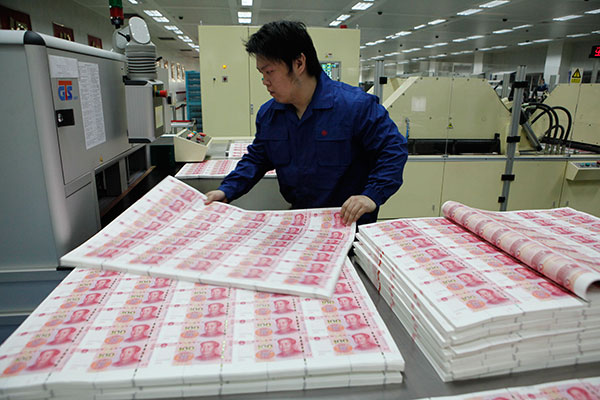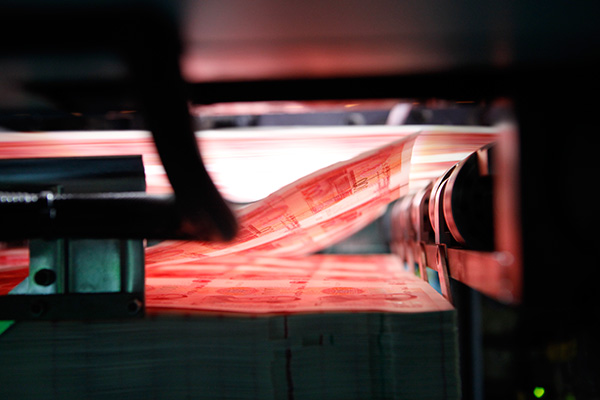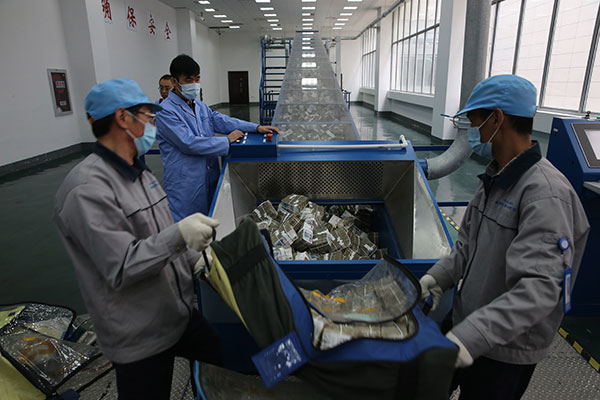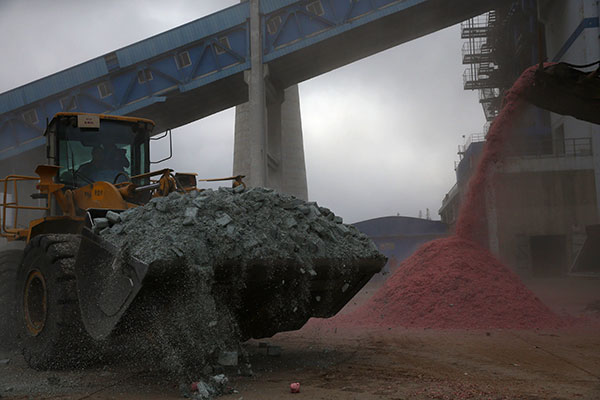
A worker prepares to cut 100 yuan bank notes printed on large sheets into separate bills at the Beijing Banknote Printing Co on Oct 29. [Photo by Yan Ping / China Daily]
The People’s Bank of China regards its bills as the country’s business cards, so every effort is made to ensure they remain clean and undamaged, report Cui Jia in Nanjing and Yancheng, Jiangsu province, and Chen Jia in Beijing.
On Nov 5, workers at a biomass power plant in Yancheng city, in East China’s Jiangsu province, opened the door of a truck and watched as 34 metric tons of blocks of shredded, compressed green paper tumbled to the ground. The blocks were pushed together to form a small mountain, next to several other teetering piles of finely shredded paper, this time red in color.

Workers shovel rejected bills onto a conveyor belt that leads to an incinerator. [Photo by Jiang Dong / China Daily]
The bright colors meant the piles stood out from the other biomass materials, such as wooden pallets and doors, ready to be burned to generate electricity. Unlike the other waste material, though, the colored piles were special because the blocks were once bills, the green ones were worth 10 yuan ($1.60) each, while the red signified 100 yuan bills.
Business as usual
On Nov 12, as the People’s Bank of China issued the 2015 edition of the 100 yuan bill, the routine work of destroying old and damaged notes continued as usual.
The PBOC regards renminbi, or “people’s currency”, bank notes as the country’s business cards. It has a responsibility to ensure they remain in mint condition, so destroying old and damaged notes is as important as printing new ones.
The improved optical features included in the new 100 yuan bill are designed to strengthen protection against counterfeiting, and a number of advanced technologies have been developed to make it easier for vending machines and ATMs to “read” the bills and ensure that they are genuine. The new bills have a more obvious security strip and the central “100” has been rendered in a special shade of red.
Many of the new bills were printed at the Beijing Banknote Printing Co, one of six facilities owned and operated by the China Banknote Printing and Minting Corp, which is supervised by the PBOC.
The production process has four stages: Offset print for the shading; intaglio print for the main pattern including the portrait of Mao Zedong, which is raised above the surface as a special anti-counterfeiting measure; printing the serial numbers and quality control; and finally, cutting and packing. The process usually lasts about one month for each note.
Shao Guowei, chief technology officer of the China Banknote Printing and Minting Corp, who has worked in the sector for 37 years, said the bills are part of the country’s image, and the artistic quality of the design should be improved in tandem with advanced anti-counterfeiting technologies.
According to the central bank, the 2015 edition bills will circulate in parallel with previous editions and will have the same face value.
Shang Zhiyu, an official with the PBOC’s Currency, Gold and Silver Bureau, said the central bank will gradually collect dirty and damaged bank notes and replace them with the new issue to ensure that all the bills in circulation are clean and undamaged.
At the bank note processing center in Nanjing, the capital of Jiangsu province, work begins at 9 am, when bags of old and damaged bills are checked manually, then counted automatically before being destroyed.
The workers process 50 and 100 yuan notes separately, because those that can still be used must be separated from the remainder. “In addition to checking if the notes are new enough to be put back into circulation, we also have to check to ensure that their anti-counterfeiting features still work. If that’s not the case, we destroy them, even if they look new,” Dou Nan, deputy director of the center, said.
Hu Shasha, who supervises the processing of higher-denomination bills, said the workers never think about the financial value. “We don’t see the notes as money, and we cannot see them as money. They are just goods to be checked,” he said.
Each inspection team consists of two skilled workers and an industrial-grade note-counting machine. Red labels are placed on bills that can still be used, while black labels are used for rejects. “We cannot tell our friends or even family members exactly what we do. It’s a very sensitive job,” the 28-year-old said.
Before taking a strip of paper containing a bundle of 10 yuan bills to be checked and counted, staff member Li Li hit the edge of her desk with it, immediately sending out a cloud of dust that spread across the room. She can go through about 500,000 yuan ($78,500) worth of 10 yuan notes during the morning shift.
The processing plant is rank with the stench of old and dirty bills which, having passed through numerous hands, are likely to harbor bacteria, so a ventilation and sterilizing system has been installed to safeguard the employees’ health.
Once the counting and evaluation processes are complete, the notes lose their face values and become waste material, measured only by weight.
The 10 yuan notes Li had counted were put back in their bags and taken to a shredding machine where they were reduced to slivers so fine that they could never be reassembled. In the eyes of the workers who toss the bills into the machine, the notes are little more than waste paper.
The machine compresses the debris into blocks or cylinders to ensure easy transportation. The center, which is responsible for the destruction of all the old and damaged bank notes in Jiangsu, can process 7 to 8 tons per day.
Biomass boost
In March last year, the center teamed up with the Guoxin biomass power plant in Yancheng city, 270 km northeast of Nanjing, to ascertain if bank note waste could be used to generate electricity.
“The level of air pollutants emitted by burning bank note waste is lower than the national standard, and test results also show that the bills are a good material for use in electricity generation,” said Zhu Hongwei, the fuel engineer at the power plant.
Every month, the processing center sends the power plant about 100 tons of discarded 10, 50 and 100 yuan bills, which are used as fuel to generate about 100,000 kilowatt hours of electricity, he said.
To ensure the discarded bills are burned entirely, the compressed, shredded matter is further processed into powder and then mixed with straw. The mixture is then placed on a conveyor belt that leads to a giant incinerator and the life of the bank notes, touched by countless unknown hands and affecting thousands, possibly millions of lives, officially comes to an end.

New 100 yuan bills are printed at the Beijing Banknote Printing Co on Oct 29. [Photo by Yan Ping / China Daily]

Workers put bags of damaged bills into a shredding machine at the bank note processing center in Nanjing, Jiangsu province, on Nov 4.[Photo by Jiang Dong / China Daily]

The processing plant deals with thousands of damaged bills every month.[Photo by Jiang Dong / China Daily]
